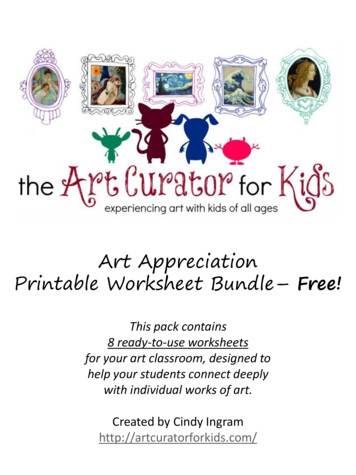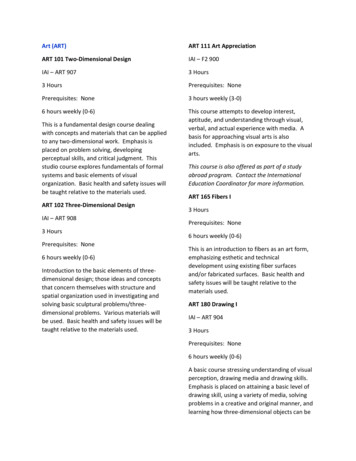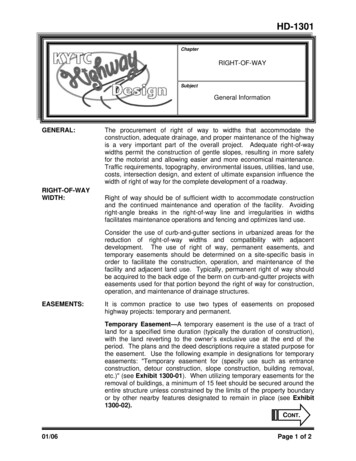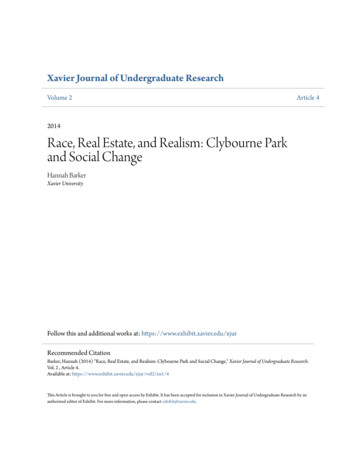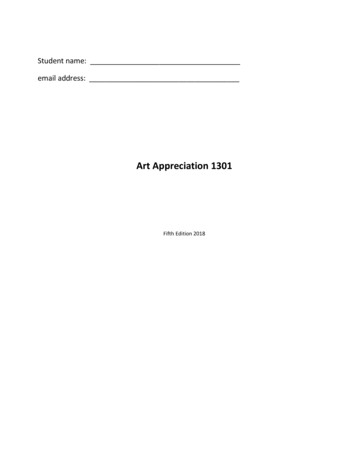
Transcription
Student name:email address:Art Appreciation 1301Fifth Edition 2018
2
Videos 2016Pachelbel Rant – Comedyhttp://www.youtube.com/watch?v JdxkVQy7QLM (5:15)Rives: “If I controlled the internet” - Poemhttp://www.ted.com/talks/rives controls the internet.html (4:04)Rives: “The 4 am Mystery” - poemhttp://www.ted.com/talks/rives on 4 a m.html (9:09)TED - Spinning Beach Balls of Death - Art ch?v W 6SfMZxoLc (3:35)Lindsey Stirling: Shadows – Violin videohttp://www.youtube.com/watch?v JGCsyshUU-A (3:55)Paperman – Love story s-short-film-paperman/ (6:33)The Employee – the-employment/ (7:08)OK GoRube Goldberg http://www.youtube.com/watch?v qybUFnY7Y8w (3:54)Car music http://www.youtube.com/watch?v MejbOFk7H6c (3:54)Parade http://www.youtube.com/watch?v UJKythlXAIY (3:57)http://www.youtube.com/watch?v VpZmIiIXuZ0 (1:31)The lamp video - ikeahttp://www.sterntag.com/?cat 22 (1:01)3
Table of ContentsExercises1. Syllabus – Collin College .52. Syllabus – Summer class schedule .83. Online course – outline/assignment .153 - 1643. Grade worksheet .104. First-day Introduction 135. Workbook processing 147. Lecture notes .15 - 286. Self-portrait Exercise .307. Critique Exercises .31 – 328. Collage Exercise 339. Visual Element presentation .34 – 3510. Visual Element Exercise 36 - 3711. Media 3812. Art Period .39 - 4013. Artist Exercise .41 - 4614. Art Work Exercise .4715. List of Works of Art . .48 - 5016. Banksy51 17. Gallery Exercise .52 - 5318. Time-line Exercise .34 - 36Forms- Art Reflections .58 - 70- Presentation Quizzes . .71 - 88- Art Periods89– 116 . .- Draw Mona Lisa .91- Current Art Period Exercise 115- Art History Assignment .117- Art period notes . 118 – 134- Art period lecture quizzes 135 - 140- Final Exam . 142 – 151- Interview an Artist . 152- MLA formatting guide . 1654
Collin College Division of Fine ArtsSample SyllabusCOURSE SYLLABUSCourse InformationCourse Number: ARTS 1301Course Title: Art AppreciationCourse Description: Introduction to the visual arts, emphasizing the understanding and appreciationof art. Reviews two- and three-dimensional art forms, methods, and media; examines thevisual elements and principles of design; and briefly surveys art styles from the prehistoric tothe 21st century.Credit Hours:Lecture Hours:33Placement Assessment: Placement in READ 0310Student Learning Outcomes: Upon successful completion of this course, students should be able todo the following:1. Use effective oral, written or visual means to communicate an informed personal reaction tocreative aesthetic processes or works of visual art and/or artists. (Communication Skills)2. Demonstrate critical thinking by correlating a creative aesthetic process or style or visualwork of art with an artist, school, region, historical period or culture. (Critical Thinking)3. Recognize essential terminology and concepts relevant to the creation of visual art works ofa stylistic period or culture, or media and process. (Communication Skills)4. Synthesize different points of view while working effectively as part of a team. (Teamwork)5. Show social responsibility through intercultural study and discovery of regional, nationaland/or global artistic traditions in the visual arts and creative aesthetic processes. (SocialResponsibility)6. Show individual responsibility through participation and/or attendance of visual art events,exhibitions, forums, lectures, group/club meetings, or other personal research, readings andinvestigations related to the visual arts. (Person Responsibility)Withdrawal Policy: See the current Collin Registration Guide for last day to withdraw.Collin College Academic Policies: See the current Collin Student HandbookAmericans with Disabilities Act Statement: Collin College will adhere to all applicable federal, stateand local laws, regulations and guidelines with respect to providing reasonable accommodationsas required to afford equal educational opportunity. It is the student’s responsibility to contact theACCESS office, SCC-D140 or 972.881.5898 (V/TTD: 972.881.5950) to arrange for appropriateaccommodations. See the current Collin Student Handbook for additional information.5
INSTRUCTOR INFORMATIONInstructor’s Name:Office Number:Office Hours:Phone Number:Email:Scott TrentL255By appointment214-202-7325 cellstrent@collin.edu (all official school correspondence), scott@inxlab.comClass Information:Section Number: P03, P04, P05, S10, 2P1 (Mon – Thrs., 1-3 pm.)Meeting Times:8:00 - 9:15 am, 10 – 11:15 am, 11:30 – 12:45 pm, 2:30 – 3:45 pm, Tue/Thrs.Meeting Location: PRC L248, A264Minimum Technology Requirement:Basic computer skills, including the ability to use MS Word, PowerPoint, some type of graphic application,such as Adobe Photoshop, and create a pdf file.Minimum Student Skills:Ability to follow directions, articulate ideas, and work within groups. Since a service learning project willbe involved with the class curriculum, a professional appearance and demeanor will be expected wheninteracting with community partners.Netiquette Expectations:All electronic communication is expected to be professional, courteous and appropriate for classroomdiscussion. Sign all email correspondences and files submitted via email must have the student’s namein the title. If uncertain whether the instructor will have the appropriate application to view the file, convertall submitted documents to a pdf format.Course Resources: NoneSupplies:NoneText book: Gateways to Art: Understanding the Visual Arts, DeWitte, Larmann, & Shields is thesuggested book by the Fine Arts Department. In this class, the text book is not required. The artappreciation work book is required. (Details provided the first day of class.)Attendance Policy:Attendance is expected. Attendance is essential for success in this class. A class presentation quizgrade requires students to be present and complete a questionnaire about student presentations.Students must be in attendance to submit quiz. This counts 15% to student’s final grade. In classassignments will not be able to be made up or provided in advance. If you miss a class, please find afellow student to provide the lesson for that day. Do not contact the instructor for the assignments for thatday. In class assignments are designed to be done in class and help evaluate the student’s overallparticipation in the course. If a student misses four classes they will not pass the course.Method of Evaluation:Grades are based on the scale of 100 points. Each assignment is worth 100 points which apply to thefinal grade based on the percentage listed below. No late work is accepted! Since most work ispresented as a class presentation, there are no opportunities to submit work late.6
Workbook- In-class quizzes- Art reflections- Gallery visit- Artist interview- Banksy- Self-portrait- Visual element exercise- Collage- Art period exercises35%Class Presentations [ 5 ]- visual elements- art- artist- media- art period40%Final exam25%100%TotalGrade scaleA (90-100)B (80- 89)C (70- 79)D (60- 69)F (Below 59)Class projects:Requirements for Participation in Collaborative Activities:All students will be expected to participate in class projects and coordinate with fellow students whengroup work is assigned.Criteria Used To Evaluate Participation In Such Activities:Evaluation will be based on a combination of group assessment, class participation, and ability to satisfyexercises as assigned.Delivery Method of Feedback and/or Graded Material:All submitted material will be returned with comments and a grade, while weekly check-ins will serve toprovide feedback and monitor the group’s progress.Standards for Instructor Response and Availability:All assignments will be graded and returned to students within one week. Email responses can beexpected within 48 hours. Face to face meetings can be scheduled twice a week during office hours orbefore/after class. Email is the quickest way to reach me, use strent@collin.edu or scott@inxlab.com7
Course Calendar:Tue., Class 1Thr., Class 2Tue., Class 3Thr., Class 4Tue., Class 5Thr., Class 6Tue., Class 7Thr., Class 8Tue., Class 9Thr., Class 10Tue., Class 11Thr., Class 12Tue., Class 13Thr., Class 14Tue., Class 15Thr., Class 16Tue., Class 17Thr., Class 18Tue., Class 19Thr., Class 20Tue., Class 21Thr., Class 22Tue., Class 23Thr., Class 24Tue., Class 25Thr., Class 26Tue., Class 27Thr., Class 28Tue., Class 29Thr., Class 30Tue.Thr.IntroductionArt period lecture – Timeline of idealsArt lecture – self-portrait/critique exerciseRenaissance (Select visual element/design principle)Visual element presentationBaroque - RococoVisual element presentationNeo-Classicism (Select media)Media presentationRealismMedia presentationRomanticism (Select artist)Gallery exercise – no class meetingImpressionismArtist presentationPost-ImpressionismArtist presentationCubism (Select art)Art presentationSurrealismArt presentationDada (Select art period)Art Period presentationAbstract Expressionism – Pop ArtArt Period presentationMinimalism – Post ModernismBanksy ExerciseWorkbook dueIn-class assignmentStudent conferencesFinal Exam Week8
Summer Class Schedule:Mon., Class 1Tues., Class 2Wed., Class 3Thurs., Class 4Introduction - workbookArt lecture – Timeline & value of artVisual element lecture – group presentation due Mon.Group work (visual element) – Interview an ArtistMon., Class 5Tues., Class 6Wed., Class 7Thurs., Class 8Visual element presentationsRenaissance - Baroque – Rococo (lecture test 1)Visual Element exercise – group workSelf-portraitMon., Class 9Tues., Class 10Wed., Class 11Thurs., Class 12Realism - Romanticism - Neo-Classicism (lecture test 2)Assign artist exerciseImpressionism - Post-impressionism - Cubism (lecture test 3)Presentation – ArtistMon., Class 13Tues., Class 14Wed., Class 15Thurs., Class 16Pop art – Dada – Surrealism lecture – assign collage exercise (lecture test 4)Collage presentationsAbstract Expressionism – Minimalism – Post Modernism (lecture test 5)Gallery visitMon., Class 17Tues., Class 18Wed., Class 19Thurs., Class 20Presentation – Banksy(Workbook due!)Student conferencesFinal9
Student name:35%Workbook40%Presentations25%Final examFinal Grade:PresentationsWorkbookVisual elementIn-class quizzesCollageMediaArt reflectionsVisual ElementArtistGallery visitArt PeriodArtArtist interviewSelf-portraitBanksyReceiptUse the worksheet below to track your grades for the semester.Please leave the form above for the instructor to calculate the final grade.35%Workbook40%Presentations25%Final examPresentationsWorkbookVisual elementIn-class quizzesCollageMediaArt reflectionsVisual ElementArtistGallery visitArt PeriodArtArtist interview10BanksySelf-portraitReceipt
Grading rubricA1.2.3.4.5.6.7.8.Well researchedAccurate informationDemonstration of knowledge of subjectOrganizedComprehensive presentationAppropriate citationsMLA formattingPictures NOT wordsBAt least 5 of the above elements of workCNo more than 2 of the above elementsD (65) Did somethingAll work turned in after due date or after presentation day will receive a 75 unless the work does not warrantthat grade.Some assignments require attendance on presentation day – these assignments cannot be made-up outside ofclass – NO exception.11
Lecture Notes12
Art AppreciationFirst Day Introduction1. Name (Scott or Dr. Trent)2. Education – Experience – Professional accomplishments3. Exchange contact information – class support each other4. Syllabus Contact information (Do not use canvas message)Text book - PJ’s Text books, 5995 Preston Rd, #105, Frisco 214-872-3222Workbook – Internet research – 3 sources citedTest – no final exam – quizzesAbsencesLate work (75 work out of class)Final exam – must be present (25%)Grading metricSemester schedule5. Expectations Talk & Think6. Class starts on time - art reflections7. Student introductions Academic career Professional career ?13
Art AppreciationWorkbook processing1. Name on inside of workbook2. Check that letters and numbers are used on final exam page 1223. Mix - Grade first half of final exam (pg. 122 )4. Write name on cover of book5. Fill-in grades - Populate workbook with grades from online gradebook6. Self-assessments Second half of final exam (3 legitimate characteristics & drawing)Art reflectionsQuizzesSelf-portraitGallery visitArtist interview7. Fill-in and calculate grade worksheet (pg. 9)8. Write your hoped grade – top right corner of page (pg. 9)9. Hand-in workbook14
Introduction to ArtLectureDay #1 What is Art? - John Cage, 14’33 Performed by the London Symphony OrchestraWho is an artist?The illusion of art - OK Go, Needing/GettingWhat are visual elements? - El EmployeeTypes of art: Abstract, realistic, impressionism, cubist, kinetic, performanceClassifications: Classic, Fine art, pop art, craft, design, sculpture, installationRecreate art - Draw Mona Lisa exercise pg.Day #2 Art timeline - New ideas - 2 cellosWhat is the value of art to society? Frank GehryAffect/purpose of art - Richard Serra, ikea lampWhat is the value of art? Edvard Munch - 119,000,000To fully understand and appreciate a work of art – recreate it.Draw Mona Lisa, Leonardo da Vinci1. What are dominating features of painting?2. What are elements which are aesthetically appealing?3. What features stands out about subject?15
ARTIt’s easy to confuse our appreciation for art with a personal preference or aesthetic bias.The individual’s preference is irrelevant to the larger purpose of public art. The value of such art is the dialoginspired and passion incited. Art that sparks conversations between strangers is more valuable than the artwhich has no voice or no more character than a potted plant.Christo and Jean Claude are artists who create large-scale, public installations. One work created in 1995, titled“Wrapped Reichstag” was a castle in West Berlin, Germany where the art team completely wrapped the castlewith polypropylene sheeting. They covered the entire structure using 1 million square feet of material and 9.7miles of blue polypropylene rope. The entire process took 24 years to complete. They left it up for 14 days. Youmight ask, why? Or, what’s the point? Christo would respond, it’s more about the process of creating such aproject, and less about the final art. I would add, what else could have inspired an entire town to come togetherand interact? Whether you understand the millions spent or appreciate the vision of the artists, you mustrecognize the impact of the art and see that the work inspired thousands of people to have conversations andinteractions they would not have had otherwise.Photo: Wolfgang Volz16
17
Introduction to art Classic artType art (classic, fine, design, craft)What is art?Who is an artist?What affect does art have? (example- Richard Serra)What makes a painting worth 120 million dollars?Why do we study the artists we do?What is the value of art to society?The illusion of artIf you want to understand a work of art – recreate it.What is art?Art is anything created withintention of being art by an artist.If I place a marker on the desk in an upright position, with the cap lying next to it, and the label is facingoutwards, it can be art or simply a marker placed on the desk. The distinction is who placed the marker andwhat was the intention of the placement. An instructor placing the marker on the desk, in between notes onthe whiteboard is not art. If the instructor places the marker as an artist, with intention for the marker to be art,and consideration of the marker’s presentation impact on an audience or message conveyed, then its art.A critic, scholar or curator can judge the work whether the new creation is worth our attention; but, they cannotclaim whether the “work” is art or not.Identifying the artist’s intention in the creation of the art is the factor necessary to understand, appreciate andjudge art.Fine art is created with no purpose, cannot have a function, is not designed to solve a problem or created to sell.Fine art is the created for the primary purpose of creative expression. This means to create something differentthan what was present before and not have an ulterior motive for the work. This can take any form; but, mustbe created with the primary purpose of original expression to be fine art.Pop art on the other hand is created with the purpose of appealing to the masses. The intention of the artist isto create something which resonates with the audience and has a message or design which is accessible to atarget audience.Where the fine artist is not creating for a target audience, sometimes their work is not understood orappreciated; hence, the moniker, “starving artist” applies.18
The challenge for an art curator and primary objective for any master art plan is not to appeal to the masses;but, identify spaces and hosts who have an appreciation for the art and make sure the art is a respectfuloccupant to the environment. This considers scale, safety issues, how the work complements the currentoccupants and how does the art enhance its surroundings. This does not and cannot prioritize personalpreferences or fight to justify the funds against practical needs of the community. Art will always be an esotericendeavor which cannot compete with the fundamental needs of the surrounding area. This is part of the valueof art as it represents a higher level of thinking. Art reflects a cultural community with a rich sense of history,personal introspection and attention to the greater good of the community, beyond the walls of our home.Abraham Maslow’s Hierarchy of NeedsArt is found at the top of Maslow’s hierarchical pyramid and represents a community who can think inabstractions and beyond the day to day routines of everyday life.19
Classic ArtAll art presented in class must satisfy the classic work of art distinction.Answer the following questions to gauge whether a work of art or artist fits the classification of classic: Has the artist/art been thoroughly studied by academic or scholars?Classic art has been vetted by scholars who deem the work noteworthy. Does the artist have a documented body of work?Classic art includes a body of work which represents more than the artist, but an art period. Have art experts and/or critics deemed the work worthy of the public’s attention?Classic art is not about being good, but a demonstration of a new way of thinking or seeing theworld. How much can you find written about the artist and their work?There are many, many artists, but not all deserve to be studied. Classic artists are vetted anddocumented. Where has the work been exhibited?Art show, galleries and museums serve as representatives of the art world and employ expertswho vet works of art. You can gauge the importance of art by venues where it is exhibited. Do any museums have the work on permanent display?If the art experts at a museum deemed a work of art worthy of purchasing this is an indicationthe art is classic. Is the artist credited with leading an art period or expressing a new technique or vision of the world?Classic artist are the few who are innovative, thought leaders, who often lead a movement,identifying unique ways of representing a generation or society.20
Who is an artist?An artist is anyone who claims to be an artist.You cannot dispute whether someone is an artist if they claim the title, artist. You can critique their work,debate the uniqueness of value of the work; but, you cannot require a degree, certificate or training to wear themoniker, artist.Why do we study the artists we do?The 100 artists which every textbook chronicles and most art students recognize are chosen because of theircontribution to the history of art.Art is broken into art periods which reflect a movement or epoch where new ideas are explored, techniquestested or the world is reflected differently.The artists noted as remarkable are the pioneers in their respective field. They might be the first to utilize a newtechnique or pushing innovative works which represent new ideas. In the music industry, it can be a new soundor a completely new way of telling a story for literature or music industry. In the visual arts, the artists whodefines an art period art those who apply paint to a canvas in an unorthodox fashion such as Jackson Pollock orpainters who view the world though a different lens and express their unique perspective in ways not yet seensuch as Pablo Picasso. Other artist make their mark by emphasizing specific points of view which are new to theaudience such as Marcel Duchamp with his sculpture titled, “Fountain” in 1921 which was actually a signedurinal.What are the categories of art?There are many categories of art from the visual arts to performing arts and musical performances. Asdescribed before, art is anything created by an artist with intention; yet, one can find a deeper understanding ofthe creation by identifying the type and categorization of art.Generally speaking, when we refer to the visual arts, they have been divided by classic art, fine arts, design orcraft. Classic art is any creation by an artist which scholars, academics, critiques or experts deem as worthy ofstudy. To warrant this distinction, the art must be innovative, new, explorative, expanding a field or redefiningan industry. Anything can be a classic work of art, in any timeframe, as long as it’s been reviewed by the expertsand deemed worthy of the public’s attention.An example of a classic work of art which was deemed innovative and new by the next day of creation is MichaelJackson’s music video, Thriller. Jackson was an accomplished artist, who had a body of work studied by critics,scholars and industry experts, so when he released the video, he already had the attention of experts and thework was deemed as worthy of our attention immediately as a new and innovative work of art.21
Classic art is never judged by the qualification of whether it’s “good.” Good or bad are personal preferenceswhich do not always reflect the artist’s intention. The success of classic art is gauged by the artist’s ability toexpress his/her intention.The experts will look at the art by the artist’s intention compared to the art field, art history and work done bycontemporary artists. Pop art utilizes a different criterion for success, as the popular artist creates work which isdesigned to resonate with a specific audience. The art is created with the intention of connecting with theaudience and therefore, success is much easier to gauge by how many people appreciate the work. A fine artistmay never sell a work of art as their intention is purely focused on self-expression and not reliant on theapproval of an audience.Craft is art which is created that has a purpose. A quilt, vase or pieces of furniture are all examples of crafts.The Tiffany Company has made lamps which are works of art; but, will always be identified as crafts becausethey have a practical application. Pottery is a craft, just as an artistic clothing accessory will always be a fashiondesign or craft; but, never fine art.Art typesThe type of art describes the process, medium and way the audience interacts and views the art. The type of artconsiders materials and resulting effects, and medium which dictates how the viewer sees the art or experiencesthe work. Kinetic – Art which integrates some moving elements into the design.Installations – Art which invites the audience to participate in the work.Site specific – Designed to interact with the surrounding environment and engage the people whooccupy the space.Mural - A painting which is applied directly to a wall or structure.Painting – Any work of art which utilizes a medium (paint) with pigment and applies this coloring to asurface.Sculptures: Metal, Wood, Stone, Bronze – A 3-dimensional work of art which often is viewed frommultiple viewpoints.Performance – A temporary exhibition performed for an audience for entertainment value.Water fountain – A sculpture created with water as the medium.Lighting – Art created with light which can be sculptural or similar to a photograph or share qualities of apainting.Mosaic - The use of tiles or glass, pieced together on a 2-dimensional surface to form a work of art andpresentation.Photography – An image created with the use of a camera which can be printed, projected or viewed ona screen.22
Untitled, 2011 HAP winner, Amy TaylorStylesThe style reflects the artist’s intention in how they represent the world. It explains why the artist chose certaindesign elements and guides the audience how to evaluate the art. Styles often references an art period andtechniques and styles prevalent during that era. For the purpose of evaluating and selecting art, these aregeneral classifications taken from specific historical art movements. Realistic - An attempt to reflect the world as accurately as possible.Abstract - The artist’s interpretation of the world as they imagine it.Graffiti – A style that is urban, illegal, site specific, interacting with the environment, with tag,message or signature.Conceptual - Art were the ideal is equally important as the expression.Color field - Use of large areas of color to evoke feeling, tap into emotions or associate ideas withthe palette of colors.Landscape - Representation in realistic style of natural scenes.Surrealistic - Attempt by artists to represent subconscious ideals with no obligation to logic orreason.Minimalism - An expression utilizing the least amount of details or design elements.Impressionistic - An image which emphasizes the reflection of light and capturing an impression ofthe world with less emphasis of perceived details.Pop art - Art which resonates with common ideals utilizing recognizable symbols, icons and popularculture references.Ready-made - This is a term popularized during the DaDa art movement. Artists would takerecognizable objects and assemble them together to create a work of art.Collage - This type of art takes images, symbols and pictures; often recognizable or iconic and placesthem together in a two dimensional work of art. The collage technique is often used for art with amessage or advocacy works attempting to bring attention to a cause.Assembled - This is the three dimensional representation of a collage. Different elements combinedinto a work of art create a unique expression.Cubist - This style of art combines multiple views; including motion and time, and represents themin a single plane.23
24
Art timelineTimeline of ideas - NOT art or artistsThe art illustrates new ways of seeing or thinkingThe artists represent individuals who were leading thinkers of the timeCycle of art period1.2.3.4.5.6.Radical new idea/disruptive/cognitive dissonanceIdeas recognized by experts/scholars/critiquesSociety thinking catches up – large-scale impactNew way of thinking normalizesNew perspective/ideas permeates/impacts conventionsNext idea emergesWhat does an art period reflect? TechnologyIdeasShared idealsZeitgeistmemesPop cultureCurrent eventsReflect idealsExplore societal issuesAesthetic preferencesThinking of timePredominant trends and stylesDominant visual elementsInfluencing world eventsReaction/response to previous art period25
What are factors which can affect the length of an art period?TechnologyCurrent eventsPurpose/messageVisual ElementsTools and techniques which create the illusion of art: MoodEmotionDepthMotionTimeFeelingMessageVisceral reactionPacing – texture – audio – visual (example: The El Employee)26
The illusion of artMost art is an illusion created by the artist. For instance, the Mona Lisa by Leonardo DaVinci, is an oil on canvaspainted in 1503 which shows a woman, prominently positioned on the canvas with her provocative smile whichdraws the viewer into her world and a posture which shows a conservative, comfortable confidence. When youlook at the painting, you have an impression of her emotions, how much she weighs and even the time of day oryear based on environmental cues. No matter your interpretation, critique or assessment of the work, the factis, this is simply paint on a flat canvas, NOT a woman and no matter how realistic the image, it is an impressioncreated by the artist’s hand of applying paint and utilizing visual elements to create the illusion of a womanstaring out from the canvas.Rene Magritte says it best with his painting, The Treachery of Images, 1929 where the sentence, "Ceci n'est pasune pipe" which translate, It is not a pipe is written at the bottom of the painting of a pipe. As a surrealist artist,Magritte challenged the viewer in his exploration of paradoxes and world perceptions with imagery, words andthe juxtaposition of seemingly incompatible visual elements. Magritte was technically correct, the painting ofthe pipe is not a pipe, it is a painting which just happens to have an image that makes you think of a pipe; but, itis definitely not a pipe.The musical group, OK GO utilizes digital media to create their illusions. At times it’s difficult to place them inone “box” as a musical group, installation artists or producers of elaborate videographers. They are truly multimedia artists as they combine audio, visual and graphic design work in every project. Thei
such as Adobe Photoshop, and create a pdf file. Minimum Student Skills: Ability to follow directions, articulate ideas, and work within groups. Since a service learning project will . Art Appreciation Workbook processing 1. Name on inside of workbook 2. Check
